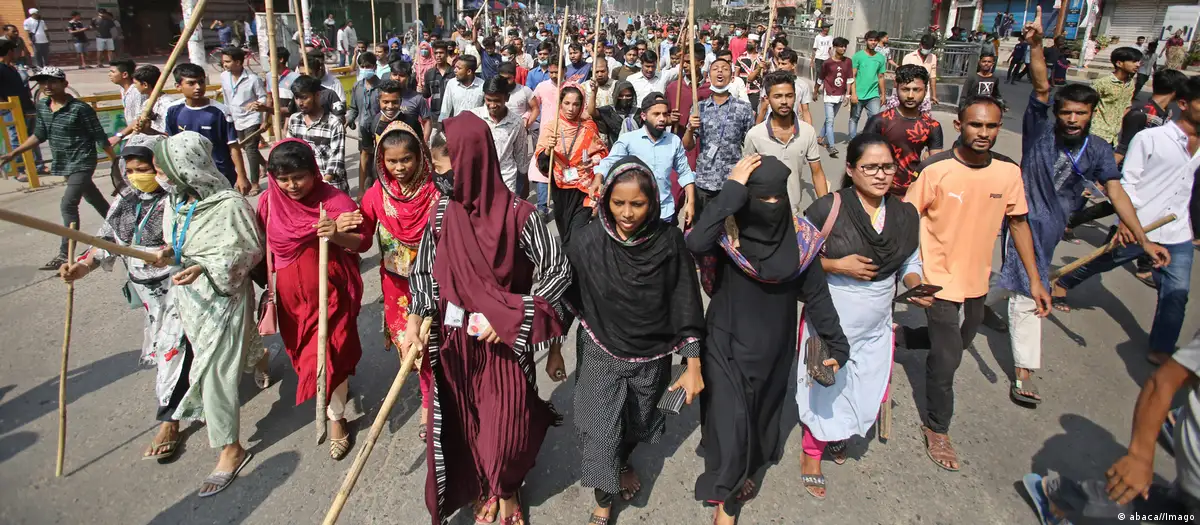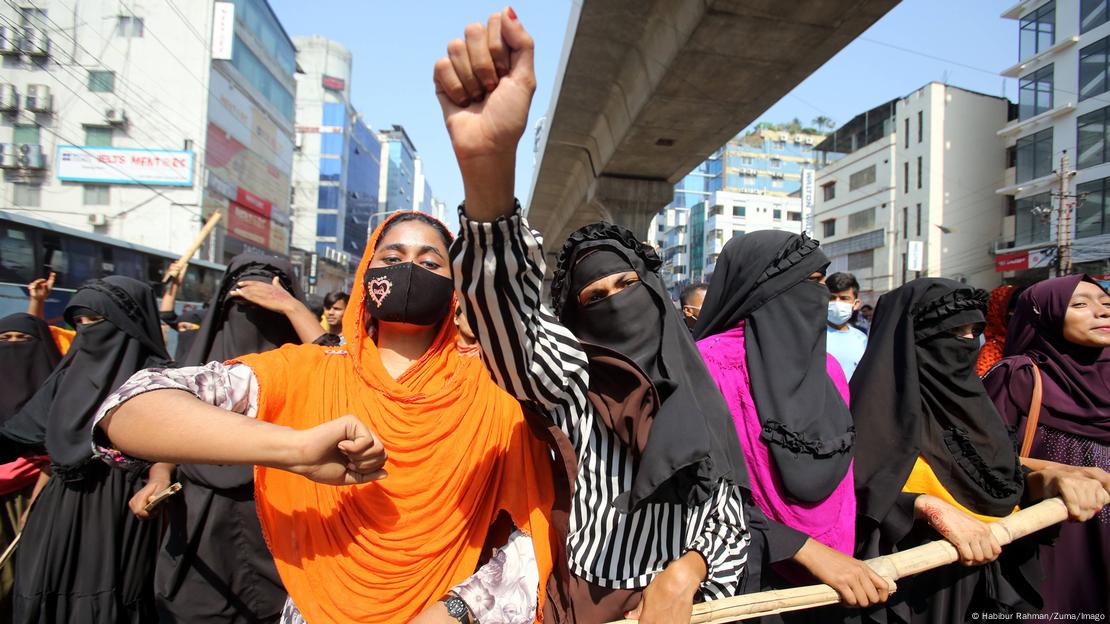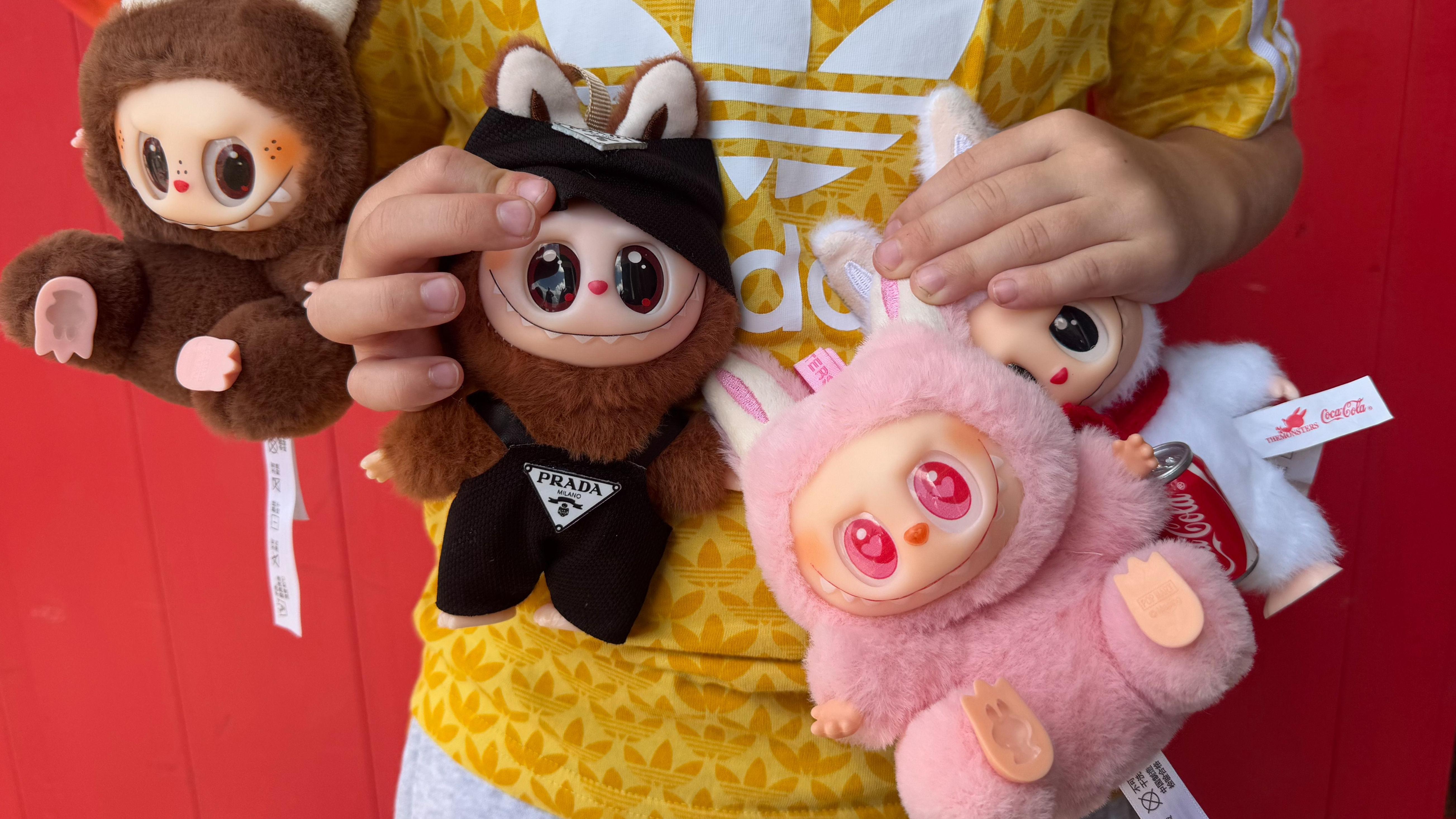Bangladesh: Garment workers say current wages unsustainable
Thousands of inflation-hit Bangladeshi garment workers have taken to the streets demanding higher wages. Factory representatives and workers' unions both say international fashion brands could help solve the problem.

Garment worker protests around the Bangladeshi capital, Dhaka, erupted again on Tuesday, as police fired tear gas at thousands of workers who set a bus on fire. For weeks, protesters have been demanding higher wages, claiming current pay leaves them unable to make ends meet.
Police on Tuesday reported a large protest in the industrial city of Gazipur, around 25 kilometers (16 miles) north of Dhaka. Some 10,000 workers walked out of their plants and staged protests following news that authorities did not fully meet their demands to raise wages. Other large-scale protests were reported in the environs of Dhaka.
Despite Bangladesh on Tuesday raising its minimum monthly wage for garment workers to 12,500 taka (€106, $113) from 8,300 taka. Some protesters said the 56% increase was too small. They're demanding a 23,000 taka (€196, $209) minimum.
Bangladesh garment makers struggle to survive
Bangladesh's 3,500 garment factories supplying many of the world's top names in fashion, including Levi's, Zara and H&M.
But conditions are dire for many of the sector's four million workers, many of who live on minimum wage, now pegged at the monthly equivalent of $113.
Kalpona Akter, president of the Bangladesh Garment and Industrial Workers Federation, told DW that life has become difficult for garment workers, as they struggle to make ends meet amid post-pandemic inflation of essential commodities.
"The workers keep shortening their food menu to cope with price hikes. They have been reducing their food items to survive," she told DW.
"If the workers can't make ends meet with their current wage, they will definitely demand the one that they can survive with," Akter added.
Sabina Begum, a 22-year-old seamstress, told AFP news agency that she joined the protests because she was "struggling to ensure bread and butter" for her family, adding the current monthly minimum wage did not cover basic needs.
Inflation in Bangladesh shot up once again in October, advancing to 9.93%, despite the government's repeated assurances of measures to rein it in, according to Dhaka's Daily Star newspaper.
A research report published by the Centre for Policy Dialogue (CPD) shows that Bangladeshi garment workers get the lowest monthly wages compared to other garment-producing countries like Cambodia, China, India, Indonesia and Vietnam.
Comprehensive cost-of-living studies by the Bangladesh Institute for Labour Studies (BILS) have shown that workers need at least 23,000 taka (€194) to stay above the poverty line.
Can the garment industry meet worker demands?
Workers have been demanding this amount as their minimum wage, as the garment industry is legally bound to review wages every five years, which falls on 2023.
"Anything lower than that will keep workers trapped in a cycle of poverty for another five years, therefore perpetuating malnutrition, debt, and child labor among garment worker families," Bogu Gojdz, the public outreach coordinator of Clean Clothes Campaign, told DW.
Garment worker federation representative Kalpona Akter said many things have changed economically since the last wage review in 2018.
"The prices of necessary goods have doubled or tripled since then. Workers' salaries increased by around 1,500 taka (€13) incrementally during this period. That's not enough at all," she told DW.

Md. Siddiqur Rahman, factory owners' representative at the wage board for garment workers, told DW that the minimum wage of the workers will be increased based on "the salary that is appropriate for our country."
"They have also demanded a minimum wage of 20,000 to 22,000 taka in the past," he said.
Rahman has claimed that the recent protests by the garment workers are more about politics than wage hike, as the protests have coincided with separate demonstrations by opposition parties demanding the resignation of Prime Minister Sheikh Hasina ahead of elections set for January.
However, workers' federation leader Akter said that thousands of workers were already protesting days before the recent political unrest started, adding they were solely concerned about their monthly wages.
"There has been a crackdown going on to dismantle the protests. Many cases have been filed against protesters. Many workers have been arrested, and some of them were labeled as political activists," she said.
Can international brands help with wages?
Gojdz from the Clean Clothes Campaign said that international brands, and especially living wage committed brands such as ASOS, H&M and Uniqlo should back the 23,000 taka demand, commit to absorbing the higher labor cost and commit to long-term sourcing from Bangladesh.
"According to the BILS study, 100% of the interviewed workers reported that their current wages are not enough to feed themselves and their families nutritious food for the entire month," Gojdz said.
"The living wage commitments of brands are nothing but empty promises as long as they refuse to explicitly support the workers' demand for a bare minimum, let alone a living wage," she added.
Industry leader Rahman also thinks that international brands have a role to play in increasing the minimum wage of the garment workers who produce clothes for them.
"An increase of 10 to 15 cents per piece by them will be enough for us. There won't be any issue here if they do so. But nobody talks about it. They push the factory owners to increase it. Where will they get money?" Rahman told DW.







